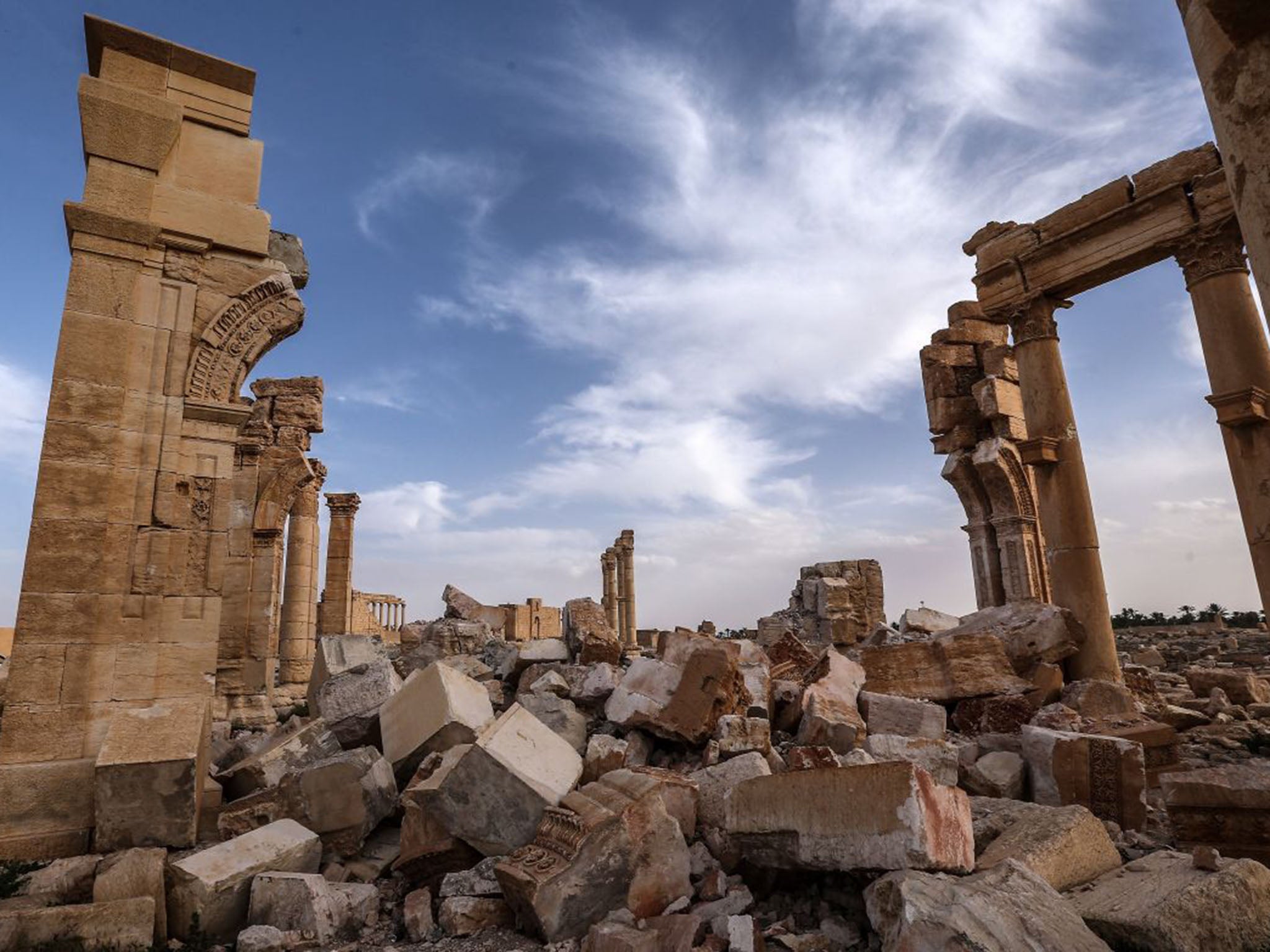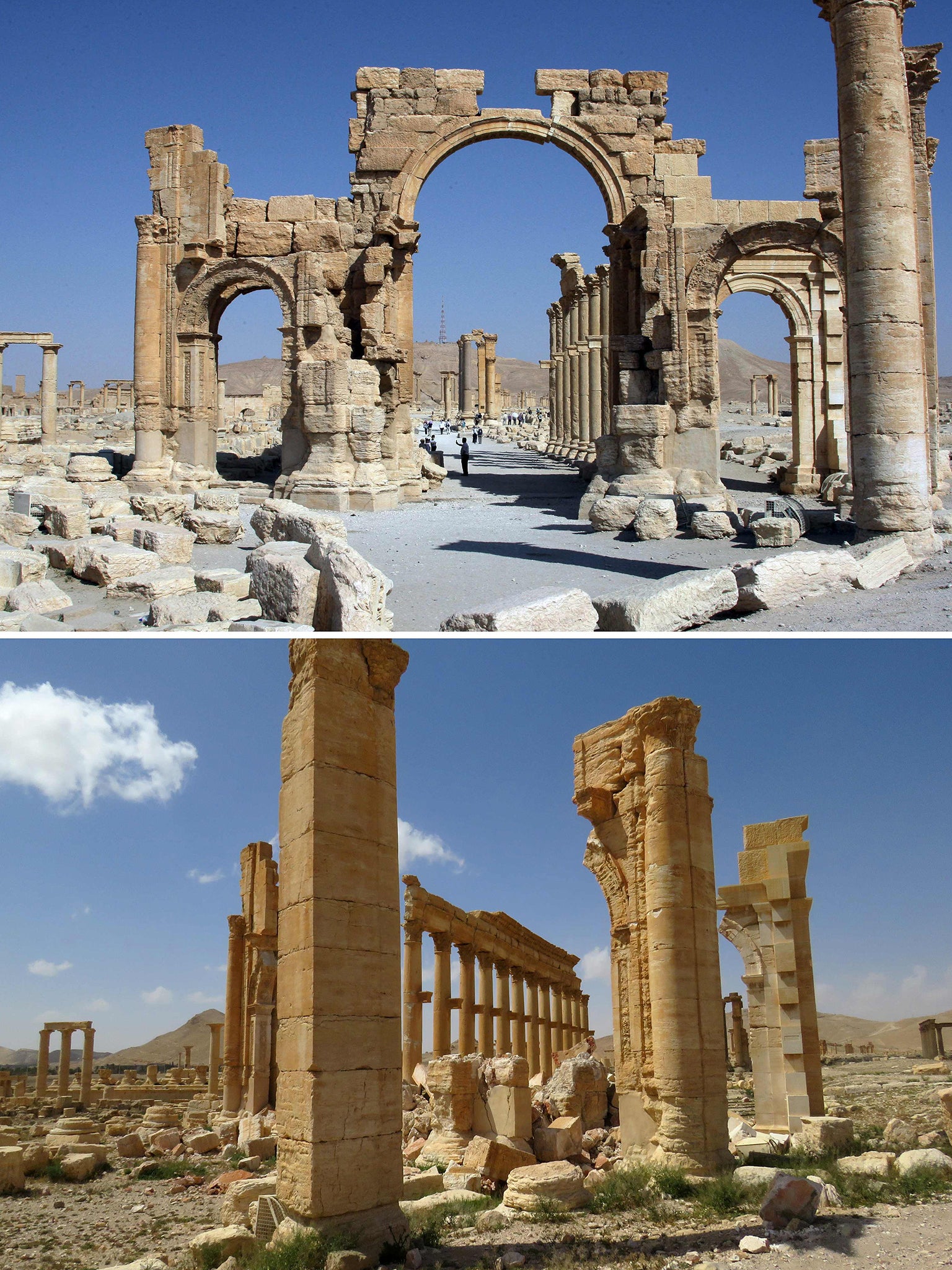As Isis is driven out, the extent of damage to Palmyra becomes clear
Two major temples appear to have been completely destroyed, but Palmyra is tragically only the latest victim of religious iconoclasm

The ancient city of Palmyra – once the capital of an empire, a symbol of resistance to Imperial Rome and, for many centuries, an icon of international trade and prosperity – once again finds itself at the heart of world events.
The iconoclasts of Isis have been driven out of this vast Unesco World Heritage site – and archaeologists are about to assess the damage. Preliminary information suggests that less of the ancient ruined city has been damaged and destroyed by Isis than previously feared.
However, two major temples – those of Bel and Baal Shamin – appear to have been completely destroyed. Certainly aerial photographs of the former suggest that the main temple building has been totally erased. However, it’s not yet clear where the rubble has been taken to – so potentially, it may be that some elements can be recovered. Also destroyed are a series of ancient tombs.
The monumental stone blocks of the great Roman triumphal arch, toppled by Isis, appear to be intact – and it may well be possible for conservators to eventually re-erect it. The ancient city’s spectacular Roman theatre has not been destroyed – probably because Isis used it for public executions. Various other structures – including several ruined temples also appear not to have been targeted by the organisation.

Syria’s head of antiquities and museums, Maamoun Abdul-Karim, told the Associated Press that a team from his department will head to Palmyra to estimate the losses. That will only happen, however, once bomb squads finish removing explosives planted by the extremists before they lost the town.
Its campaign of destruction was methodical and centrally planned. A special Isis unit was apparently tasked with selecting targets and implementing the destruction.
However, although the Isis destruction of parts of Palmyra has attracted worldwide attention, it represents only a small percentage of the total cultural destruction wrought so far by the organisation.
In Iraqi, Syria and Libya, Isis has systematically destroyed more than 30 major historic churches, mosques and tombs – some of which date as far back as the seventh century. Muslim monuments damaged have included some Sunni as well as Shia ones.
Ancient Assyrian sites (especially large pagan statues) have also been targeted by Isis. The organisation’s main motivation appears to be a disapproval of any religious sculptures of any sort – and of religious movements that they consider heretical. It also strongly disapprove of paganism, monumental tombs of any sort – and of all figurative religious decoration.

In its zeal, it is, of course, merely the latest in a long global succession of destroyers of cultural heritage. As far back as the 14th century BC, religious radicals and traditionalists in ancient Egypt sought to damage or destroy iconography and even temples they did not approve of.
In the first century AD, pagan Rome deliberately destroyed the great Jewish Temple in Jerusalem – and in the late fourth century AD, Rome (by then Christian) damaged and destroyed many pagan temples.
In 8th and 15th century northern India, Muslim rulers destroyed Hindu temples – and in 16th century Europe, Protestant radicals destroyed vast quantities of Catholic art.
In what is now Saudi Arabia, some important religious monuments, including mosques, have been demolished at various stages over the past 200 years.
Buddhist cultural heritage has also suffered – at the hands of fundamentalist Christians in South Korea and at the hands of the Taliban, which destroyed the vast 53 metre tall statue of Buddha at Bamiyan in Afghanistan in 2001. Palmyra is tragically only the latest victim of religious iconoclasm.
But the ancient city has has suffered far worse in the past – and has, on each occasion, quite literally risen from the ashes and the debris of what people at the time thought was terminal oblivion. In 273 AD, the city rebelled against Rome and was utterly destroyed as a brutal punishment. But it was eventually rebuilt.

Then in 1068 and 1089, it was again devastated – this time by massive earthquakes. Finally the Turco-Mongols under Tamerlane destroyed the city in 1400. But people continued to live there are among the ruins until the early 20th century.
Today the modern successor to Palmyra – nearby Tadmor, which suffered much under Isis occupation - continues a tradition of human settlement and achievement that started almost 10,000 years ago. Hopefully, despite the ravages of time and Isis, Palmyra will continue to amaze the world for centuries to come.
Amr al-Azm, a former Syrian antiquities official, said the world was already aware of the damage to the archaeological site, but was only now seeing the destruction wrought inside the Palmyra museum. “What was unfortunate really was the damage inside the museum, the many of the pieces that have not been saved, that they [Damascus officials] did not have time or the ability to move,” he said. “It seems that a significant amount of damage was inflicted on them.”
“We can renovate them,” he said. “Yes, we lost part of the original but we didn’t totally lose them.”
Join our commenting forum
Join thought-provoking conversations, follow other Independent readers and see their replies
Comments
Bookmark popover
Removed from bookmarks